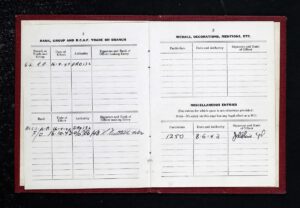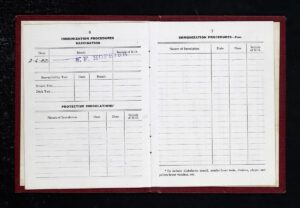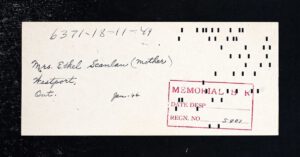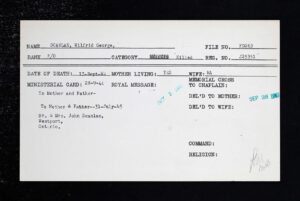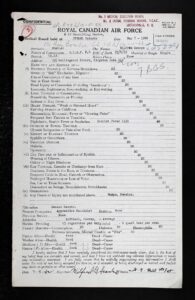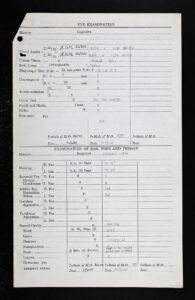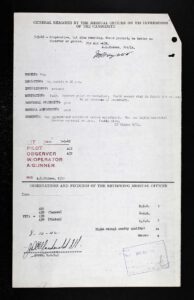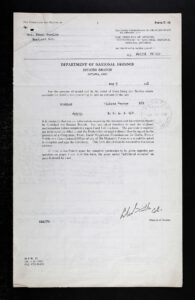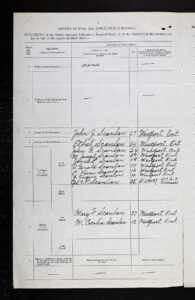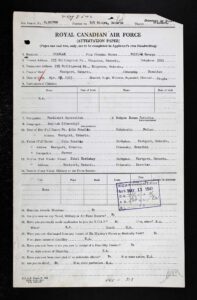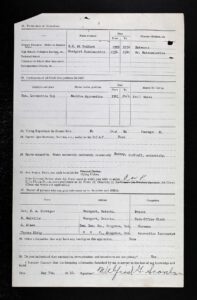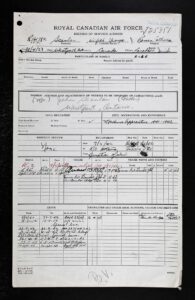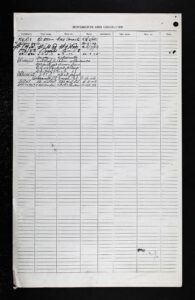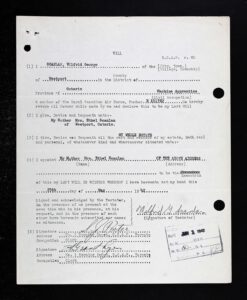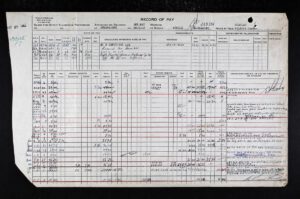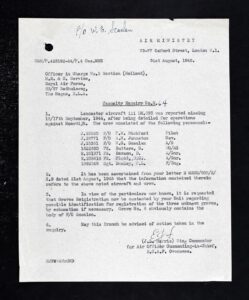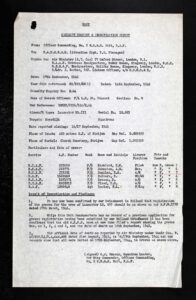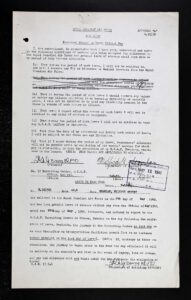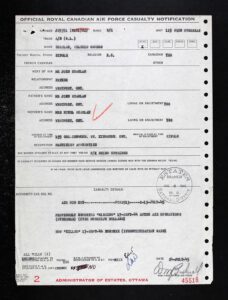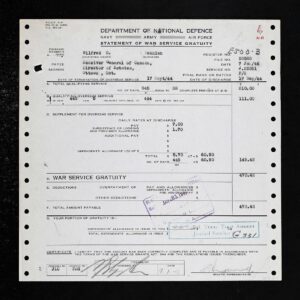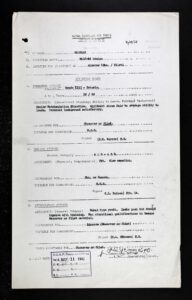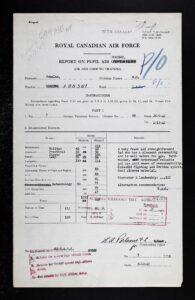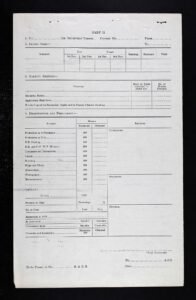81 – Wilfrid G. Scanlan 21 jaar (April 23, 1923 – September 16, 1944)
Wilfrid George Scanlan, levensbeschrijving door Bob Scanlan
 Wilfrid was born on April 23, 1923, the fourth of ten children of John and Ethel Scanlan, in a farmhouse near the village of Westport ON. He was preceded by a sister, Mary Frances, born December 3, 1917; brothers Terence Patrick, born January 15, 1920 and John Gualbert, born July 12, 1921 and proceeded by brothers, Michael Joseph, born September 2, 1924, James Leo, born February 22, 1926, Thomas Gerald, born August 27, 1927, Charles Kevin, born June 5, 1929, sister Margaret Cecilia, born April 7, 1932 and brother Francis Eugene, born April 13, 1935. He received his early schooling at a nearby one room school. {A brisk two mile walk each way?} After completing 8th grade he began high school classes in Westport at St. Edward Catholic High School. His teachers were all members of the Congregation of Notre Dame. All were excellent teachers and students were well versed in English Literature, Composition, Mathematics, French and Latin. The school was situated beside St. Edward Church and the parish priest was actively inolved in oversight of the school and its students and ensured the influence of the Catholic faith was present in everyday studies. At home there were cows to be milked daily along with their feeding and care and all of the duties of helping with an active farm. Along with being proficient at sports Wilfrid was interested in all things mechanical and in particular a motorcycle owned by a neighbor Mr. E. Asseltine. His brother Euguene recalls that he was also alert for any passing aircraft and was soon able to distinguish makes and models. He, like many of his siblings, had some musical talent and liked to play the fiddle and mouth organ. After leaving high school, Wilfrid found employment, along with brother John, in manufacturing at the Locomotive Works in KIngston. Canada declared war on Germany in 1939 and as the war raged on, Wilfrid decided to join in the fight for freedom. In January of 1942 he applied for enlistment in the RCAF and was accepted and enrolled on May 7, 1942. Wilfrid was assigned to a training session at an air base at Victoriaville Quebec. Younger brother Eugene recalls that Wilfrid, while on leave in Montreal during his Quebec assignment, met his first cousin Dorothy Lynett. Following completion of initial training, he was transferred to Fingal Ontario for advanced training. He was certified as Air Bomber (AB) on April 16, 1943. Later he was assigned to a base near London Ontario where he was appointed as Flying Officer (F/O) on October 16, 1943. Opon completion of training Wilfrid and his fellow airmen embarked for overseas on June 30, 1943, arriving in the UK on July 7, 1943. After arrival in England, Wilfrid wrote home often, telling of how he loved being in the Air Force. He also reported that he had met his elder brother Terence who was already serving in England as an RCAF plane maintainer. Over the next months Wilfrid completed many more hours of training and became part of 115 Squadron’s combat assignments. It is known that by mid-September 1944 Wilfrid’s crew had completed 29 sorties or trips. 30 trips meant the end of a tour and a period of rest and recuperation. On September 16, 1944 his plane, Lancaster LM693 was involved in a fatal collision with another Lancaster as they were bombing the approaches of Moerdjik bridge. There were no survivors. The remains of the seven crewmen rest in Strijen Protestant Cemetery, tended lovingly by the citizens of Strijen. It is ironic that just days after his death, German forces began to withdraw from Holland. We must stand in admiration of these gallant young men; the youngest crewman just 19 and the eldest only 28. They stood between the free world and the scourge of the Nazis’ when there was almost no hope. What might these young men have become in future years had they survived?
Wilfrid was born on April 23, 1923, the fourth of ten children of John and Ethel Scanlan, in a farmhouse near the village of Westport ON. He was preceded by a sister, Mary Frances, born December 3, 1917; brothers Terence Patrick, born January 15, 1920 and John Gualbert, born July 12, 1921 and proceeded by brothers, Michael Joseph, born September 2, 1924, James Leo, born February 22, 1926, Thomas Gerald, born August 27, 1927, Charles Kevin, born June 5, 1929, sister Margaret Cecilia, born April 7, 1932 and brother Francis Eugene, born April 13, 1935. He received his early schooling at a nearby one room school. {A brisk two mile walk each way?} After completing 8th grade he began high school classes in Westport at St. Edward Catholic High School. His teachers were all members of the Congregation of Notre Dame. All were excellent teachers and students were well versed in English Literature, Composition, Mathematics, French and Latin. The school was situated beside St. Edward Church and the parish priest was actively inolved in oversight of the school and its students and ensured the influence of the Catholic faith was present in everyday studies. At home there were cows to be milked daily along with their feeding and care and all of the duties of helping with an active farm. Along with being proficient at sports Wilfrid was interested in all things mechanical and in particular a motorcycle owned by a neighbor Mr. E. Asseltine. His brother Euguene recalls that he was also alert for any passing aircraft and was soon able to distinguish makes and models. He, like many of his siblings, had some musical talent and liked to play the fiddle and mouth organ. After leaving high school, Wilfrid found employment, along with brother John, in manufacturing at the Locomotive Works in KIngston. Canada declared war on Germany in 1939 and as the war raged on, Wilfrid decided to join in the fight for freedom. In January of 1942 he applied for enlistment in the RCAF and was accepted and enrolled on May 7, 1942. Wilfrid was assigned to a training session at an air base at Victoriaville Quebec. Younger brother Eugene recalls that Wilfrid, while on leave in Montreal during his Quebec assignment, met his first cousin Dorothy Lynett. Following completion of initial training, he was transferred to Fingal Ontario for advanced training. He was certified as Air Bomber (AB) on April 16, 1943. Later he was assigned to a base near London Ontario where he was appointed as Flying Officer (F/O) on October 16, 1943. Opon completion of training Wilfrid and his fellow airmen embarked for overseas on June 30, 1943, arriving in the UK on July 7, 1943. After arrival in England, Wilfrid wrote home often, telling of how he loved being in the Air Force. He also reported that he had met his elder brother Terence who was already serving in England as an RCAF plane maintainer. Over the next months Wilfrid completed many more hours of training and became part of 115 Squadron’s combat assignments. It is known that by mid-September 1944 Wilfrid’s crew had completed 29 sorties or trips. 30 trips meant the end of a tour and a period of rest and recuperation. On September 16, 1944 his plane, Lancaster LM693 was involved in a fatal collision with another Lancaster as they were bombing the approaches of Moerdjik bridge. There were no survivors. The remains of the seven crewmen rest in Strijen Protestant Cemetery, tended lovingly by the citizens of Strijen. It is ironic that just days after his death, German forces began to withdraw from Holland. We must stand in admiration of these gallant young men; the youngest crewman just 19 and the eldest only 28. They stood between the free world and the scourge of the Nazis’ when there was almost no hope. What might these young men have become in future years had they survived?
(Prepared by Bob Scanlan, December 16, 2016)
A candle every year …
On Christmas Eve candles are lit all over the Netherlands at war graves. In the Hoeksche Waard this has been done since 2016, at the Canadian cemetery in Holten this tradition has persisted for more than 25 years. It gave Dick Jansen from Burgum the idea to draw national attention to this campaign via Facebook. Through his efforts, candles are burned at the graves in hundreds of places in the Netherlands every year. The initiative is seen as a wonderful gesture at an emotional moment, for those who gave their lives for our freedom in World War II.

Strijen cemetary

Documenten – Documents Scanlan


